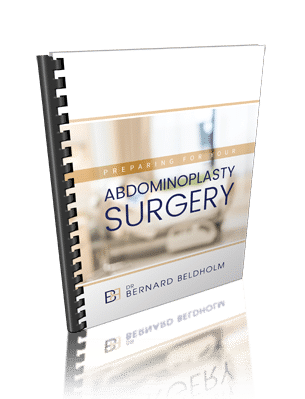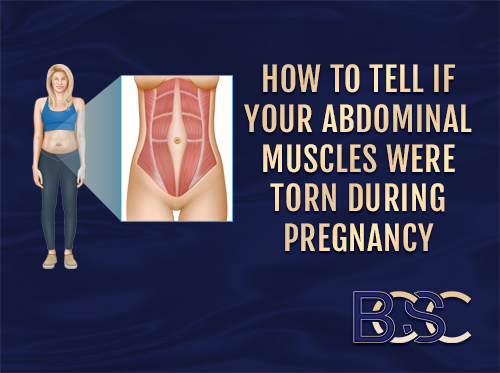Post Pregnancy ** Mons Pubis and Fatty Upper Pubic Area (FUPA)
FUPA (Fatty Upper Pubic Area), also known as bulging or ** mons pubis, occurs when fat accumulates around the mons pubis due to pregnancy, abdominal surgery, or massive weight loss. The mons pubis is the region between the genitals and the pubic hairline, shaped like an upside-down triangle.

8 months pregnant woman
After pregnancy or a major weight loss, many women may notice an accumulation of fat around the mons pubis, giving it an unpleasant bulging or ** effect. Other factors that may result in loose skin or fat accumulation around the mons pubis include age, genetics, hormonal changes, or gain weight and abdominal surgery like a C-section.
Monsplasty is a surgical treatment designed to remove excess fat and loose skin around the mons pubis.
What is Mons Pubis Surgery (Monsplasty)

Monsplasty helps to remove the extra skin and extra tissue from a large mons pubis making it possible to wear tight pants again.
A monsplasty (pubic lift) is a cosmetic procedure that ** the bulging/** pubic mound, getting rid of the stubborn fat in the upper pubic area. The procedure ** the excess fat and skin by tightening, lifting, and reshaping the mons pubis. The mons pubis region is the triangular shaped pubic mound tissue from the genitals to the upper part of the pubic bone, usually covered with pubic hair.
Gaining weight will result in fat accumulation around the pubis, causing it to bulge outwards. This will result in the skin around the region stretching to accommodate the extra fat. If the weight gain happens for a short period, the skin is able to stretch and retract to its original size.
However, if the weight gains last for longer periods, the skin’s elasticity wears off. Therefore, sudden loss of significant amounts of weight leaves the pubis with loose, ** skin. This results in a ** mons pubis, which is hard to get rid of with exercise or a healthy diet.
Other factors that would result in a fatty upper pubic area include:
- Age: The skin is made of collagen fibres and other interconnective tissues that affect its elasticity. The body produces collagen in low quantities with age. Therefore, the skin loses its elasticity and becomes thin, resulting in ** skin.
- Abdominal surgery (C-Section): After childbirth through a C-section, the skin around the scar remains tight. However, the skin below the scar doesn’t, and it may result in a budge in the pubis.
- Genetics: Some patients are predisposed to fat deposition in the mons pubis. This means that if a family member had the complication, the patient too might get it.
- Hormones: An increase in levels of hormones like estrogen can cause an increase in fat deposition in the mons pubis.
In addition to ** the mons pubis contour, monsplasty also ** the functionality of the region. ** mons pubis can cause reduced hygiene, infections, rashes, urination and sexual difficulties. Further, by removing this unwanted fat, monsplasty can ** self **, ** sexual intimacy, and make it possible to wear a bathing suit once again.
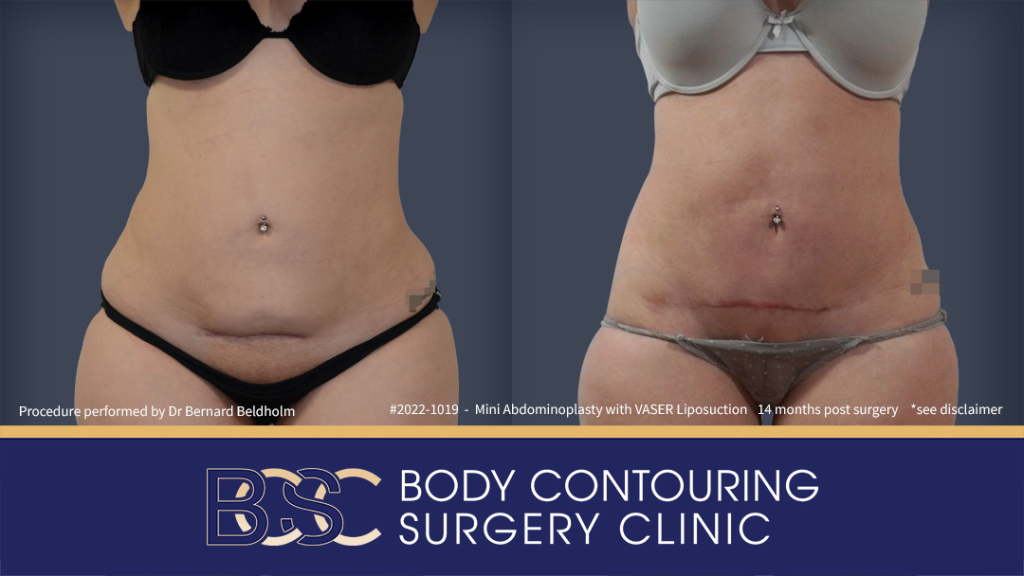
Mini Abdominoplasty with VASER liposuction
Disclaimer: Operation performed by Dr Bernard Beldholm. Adult content, surgery has risks; individual results vary, seek 2nd opinion. Please see the full disclaimer.
What is involved in a Mons Pubis (Monsplasty) surgery?
Monsplasty involves the removal of excess mons pubis skin and fat. Patients with excess fatty tissue will undergo liposuction procedures to remove the fatty tissue, while those with excess ** skin will undergo skin excision.
Before the procedure, the surgeon will make marks on the excision region. The marks act as guidelines to ensure symmetry. The next step involves anesthesia administration. The procedure takes approximately one hour, but that can be longer when liposuction is involved. It can be done has a day procedure.
Liposuction

Liposuction is carried out as the first procedure. Pubis liposuction removes excess fat but liposuction doesn’t ** excess skin. Therefore, patients with ** skin resulting from weight loss or age will require skin excision.
Skin Excision
Skin excision is suitable for patients who have developed excess loose mons pubis skin. The surgeon makes a horizontal incision on your lower abdomen, usually, the location of an abdominoplasty’s incision. After making the incision, the surgeon removes the excess skin and places the incision such that the underwear hides it.
Mons Lift
After removing the excess skin, the surgeon tightens the tissues underlying the pubic bone. The surgeon also pulls and tightens the muscle using sutures, resulting in a mons pubis lift. The incision is then closed with surgical adhesive or absorbable sutures. This process not only ** one’s aesthetic, but also ** stress urinary incontinence. A scientific study published in National Library of Medicine concludes “A combination of complete abdominoplasty with Mons full pubic lift can be offered to ** SUI in people who are interested in body shaping.”
Fat Transfer
On some occasions, fat grafting can be conducted on the mons pubis. The procedure is recommended for patients with atrophy. The surgeon harvests fat cells through liposuction from other body parts like the thighs and injects it into the mons pubis.
Combination Procedures
Monsplasty may be carried out in combination with other procedures like abdominoplasty. This is due to the proximity of the mons pubis and the lower abdomen. This ensures the surgeon uses the same incision for both procedures. In addition, a bulging mons pubis is often noticeable after the removal of excess skin and fat in the lower abdomen, therefore necessitating a monsplasty.
A study on monsplasty states that “It can be incorporated in both esthetic and reconstructive abdominoplasties and should be a standard component of the procedure for cases with mons ptosis grade 2 or higher.”
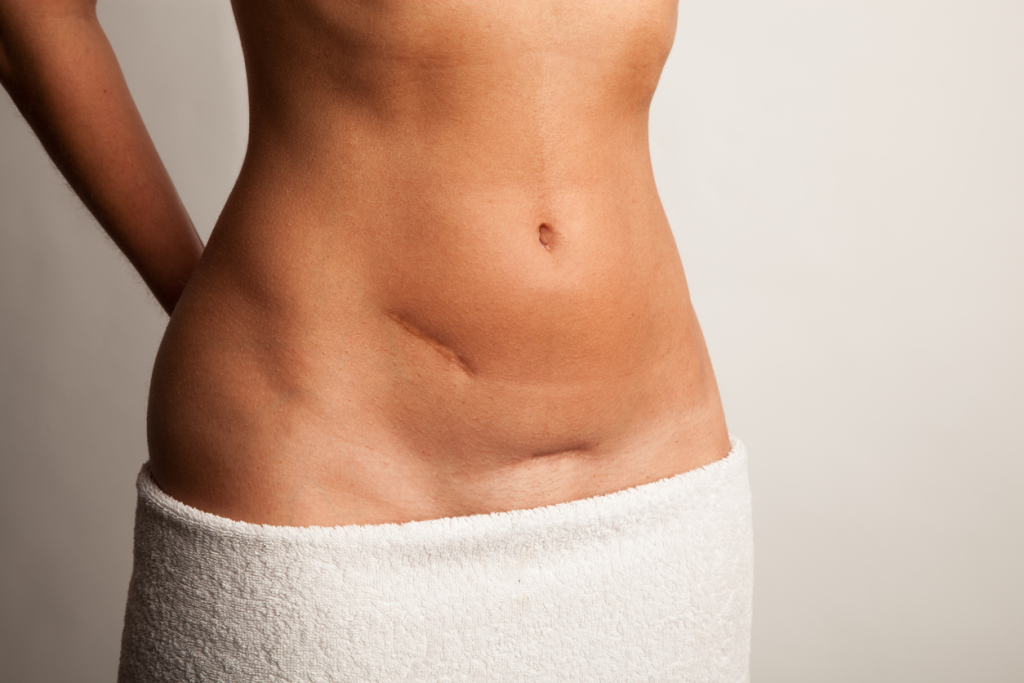
Preparing for Mons Pubis Surgery
Preparing for a monplasty involves the following process:
Initial Consultation with a Surgeon

Surgeon consultation
The patient books a consultation with a specialist surgeon where they discuss their needs and expectations. This allows the surgeon to understand the patient’s goals in order to customise the procedure.
The surgeon also discusses the expected surgical risks and helps the patient manage their expectations. At this stage, the patient can book for a second consultation or proceed to choose the surgery date.
Medical Evaluation
The surgeon does an initial evaluation of the patient’s health. This involves a careful medical examination to assess the suitability of the procedure. The surgeon considers the patient’s overall health, age, expectations, emotional well-being, weight, and medical history.
The patient should disclose their medical history and any medication they are taking to ensure the surgeon prepares adequately for all the possible surgical risks. During the evaluation, the surgeon also examines the mons pubis to assess the amount of excess skin and fat and may also take photographs for medical records.
Follow Pre-Operative Instructions
After the medical evaluation, the surgeon gives the patient a list of pre-operative instructions to follow. These include quitting medication such as anti-inflammatory drugs and aspirin to reduce the risk of excessive bleeding. The patient is also required to quit alcohol at least two weeks before and after the procedure.
Stop Smoking

Stop smoking | BCSC
The patient should stop smoking at least 6 weeks before and after surgery to minimise complications. The surgeon may suggest a longer period, depending on the patient’s smoking history. A literature review of PubMed states, “Smoking is an independent risk factor for wound healing complications, but not for free flap loss. Smokers who are candidates for plastic surgery should cease smoking for an adequate amount of time preoperatively.”
Arrange for Support After Monsplasty Procedure
After surgery, the patient will require support getting home and doing their daily chores. This should be arranged before surgery.
Prepare Your Recovery Space
The patient will require bed rest for a couple of days. Therefore, they should prepare their recovery space adequately, ensuring they have all the essentials to make the period as ** as possible.
Arrange for Time Off from Work
It takes two to three weeks for most patients to resume light chores. Therefore, the patient should arrange for time off work during this period.
Follow Fasting Guidelines
An article on pre-operative fasting notes that “Preoperative fasting is necessary to reduce the risk of regurgitation of gastric contents and pulmonary aspiration.”
Most medical practitioners recommend that patients should avoid meals for at least six hours before surgery. Clear liquids like water and coffee are allowed up to two hours before surgery. However, your anaesthetist and the hospital that you go to will advise you directly about what they recommend. This can vary.
Emotional Preparation
Emotional preparation is equally important as physical preparation. It ensures the patient is well prepared for the surgery and has realistic expectations.
Recovery From Mons Pubis
Recovering from mons pubis takes some time. Below is the expected full recovery time timeline.
Immediate Postoperative Period
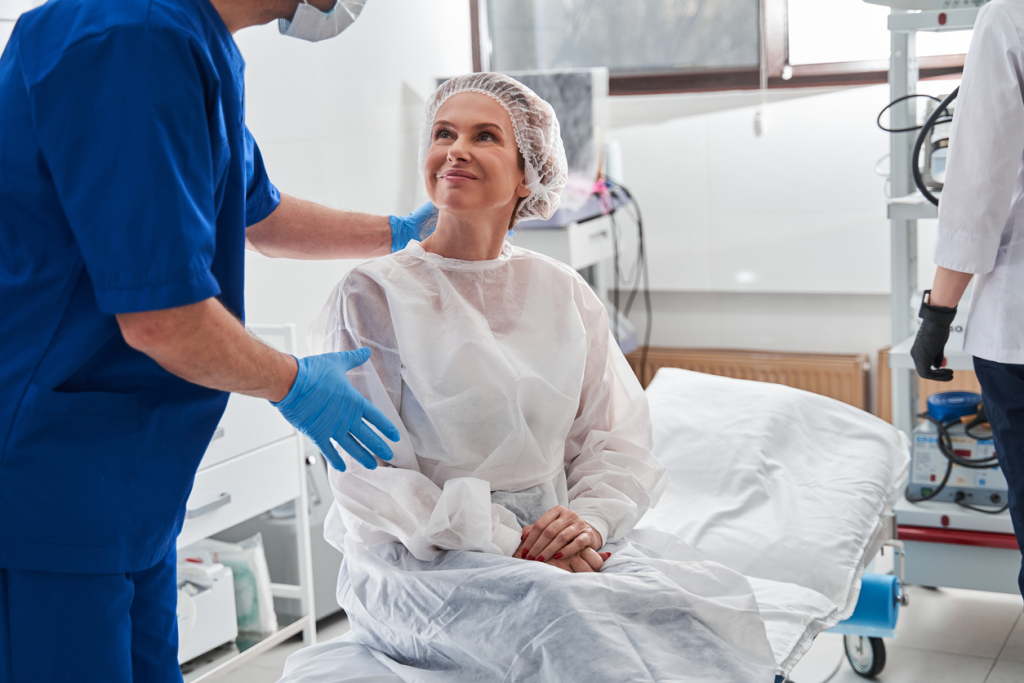
Immediately after surgery, the incision is dressed with bandages and a compression garment. The patient will experience pain after the anesthesia effects wear off. The anaesthetist prescribes painkillers to ease the pain. Dr. Bernard Beldholm MBBS B.Sc (Meod), FRACS founder and CEO of Body Contouring Surgery Clinic Pty Ltd recommends the patient stay overnight at the hospital for monitoring.
First Week
The patient experiences discomfort and pain and will have trouble moving around. However, they are encouraged to take light walks around the home after two days to encourage blood circulation which ** healing. The pain and discomfort subside gradually.
Follow-Up Appointments
Follow-up appointments ensure the surgeon monitors the recovery. During these appointments, the surgeon will also check for any wound infections and abnormalities.
Swelling and Bruising
Bruising and swelling are normal after surgery. These will be intense in the first week but subside by the second to third week. However, residual swelling takes longer.
Physical Activity
Most patients can resume work two to three weeks after surgery. However, intense physical activity is discouraged until around four to six weeks.
Scar Management
Scar management is important during recovery to prevent scar infection and bad scarring. This may involve cleaning the incision, applying scar treatments, and massaging the incision site.
Long-Term Results
The results of a monsplasty will be visible after three-six months. However, the final results may take twelve months or more as residual swelling subsides completely. Please note that results may vary among patients.
What Will the Scar Look Like After Mons Pubis Surgery?
Most patients, specifically those highly concerned with aesthetics, are worried about their post-surgery scars. There are a few factors that will determine how your scar will look like.
Placement of Incision
A monsplasty incision is placed horizontally along the lower abdomen, similar to an abdominoplasty (tummy tuck) incision. An abdominoplasty (tummy tuck) incision is used in cases where the patient has previously undergone an abdominoplasty.
Suture Technique
The surgeon uses absorbable sutures to tighten the underlying mons pubis muscles and then closes the incision with absorbable sutures or surgical glue.
Scar Care
Scar care involves scar treatments to reduce scarring. Massaging the incision site also helps to ** healing and reduce scarring.
Individual Healing
It’s worth noting that different patients heal differently due to individual factors like age, overall health, and invasiveness of the procedure.
Is Mons Pubis Surgery Painful?
Just like other surgical and cosmetic procedures however, discomfort and pain are common side effects after a monsplasty however, your surgeon will likely prescribe pain medication to manage the pain.
Risks and Complications of Mons Pubis Surgery
There are risks associated with this surgery and it’s prudent for patients to be familiar with them so that they can be well-prepared. Some of the common ones include.
- Infection and poor wound healing
- Excessive bleeding
- Bad scarring
- Nerve damage
- Asymmetry of the mons pubis
- Allergic reactions to the anesthesia
- Unsatisfactory results
- Seroma and hematoma
Pregnancy Following Mons Pubis Surgery
It’s not advisable to get pregnant after a monsplasty. However, getting pregnant may not affect the results of the procedure.
Sexual Intimacy Following Mons Pubis Surgery
Patients should follow their surgeon’s advice and allow adequate wound healing. In addition, patients are advised to start slowly and ease into it. It’s important to communicate with your partner and find what is suitable for you.
Most surgeons recommend that patients avoid sexual intercourse for at least 4 weeks after surgery.
Benefits of Mons Pubis Surgery
Understanding the potential benefits of mons pubis surgery provides individuals with valuable insight into how the procedure can positively impact their lives. These include:
- ** the mons pubis contour
- Reducing chronic infections resulting from excess skin around the mons pubis area
- ** sexual life
- Reducing difficulty in urination
- ** hygiene of the genitals
A study on monsplasty effectiveness reports “A significant ** in body image (p < 0.001), ** with the abdomen (p < 0.001), and sexual functioning (p = 0.009). Functionally, ** were recorded with regard to visualisation of the genitalia (36%), hygiene maintenance of the pubic area (32%), sex life (48%), genital sensitivity (24%), and urinary continence (4%). Patient ** was very high.”
Cost of Mons Pubis Surgery in Australia
Monsplasty costs approximately $3,000-$8,000, with an average cost of $5,000. Medicare rarely covers the cost of a monsplasty because it’s considered a cosmetic procedure.
Conclusion
Eliminating ** skin and excess fat around the mons pubis can be challenging through a healthy diet and exercise alone. Monsplasty is an effective surgical procedure that ** FUPA (Fatty Upper Public Area) and post-pregnancy ** of the mons pubis.
References
- Hamdi, M., Waked, K., Deleuze, J., Giunta, G., De Baerdemaeker, R., De Brucker, B., & Zeltzer, A. (2023). The monsplasty: Surgical and functional outcomes using an effective and reproducible surgical technique. Journal of Plastic, Reconstructive & Aesthetic Surgery, 84, 287–294.
- Thomas, M., & Dsilva, J. A. (2023). Mons Lift during Abdominoplasty Improves Stress Urinary Incontinence. Plastic and reconstructive surgery. Global open, 11(6), e5090.
- Saheb-Al-Zamani M. (2022). Mons Pubis Lift (Monsplasty). Clinics in plastic surgery, 49(4), 479–487.
- Pechevy, L., Gourari, A., Carloni, R., Sauvaget, F., Bertheuil, N., & Goga, D. (2016). Monsplasty after massive weight loss: Assessment of its aesthetic and functional impact. Annales de chirurgie plastique et esthetique, 61(1), e21–e35.
- Patoué, A., De Runz, A., Carloni, R., Aillet, S., Watier, E., & Bertheuil, N. (2018). Safe monsplasty technique. Journal of plastic surgery and hand surgery, 52(2), 74–79.
- Davies, A., Pang, W. S., Fowler, T., Dewi, F., & Wright, T. (2018). Preoperative fasting in the department of plastic surgery. BMJ open quality, 7(4), e000161.
- Mehdi, K. M., & Kumar, A. (2023). Spontaneous cutaneous endometriosis in Mons Pubis: review of literature. Medical journal, Armed Forces India, 79(1), 105–108.
- Klinger, M., Klinger, F., Giannasi, S., Bandi, V., Vinci, V., Catania, B., Lisa, A., Veronesi, A., Battistini, A., Giaccone, M., Caviggioli, F., & Maione, L. (2021). Aesthetic and Functional Abdominoplasty: Anatomical and Clinical Classification based on a 12-year Retrospective Study. Plastic and reconstructive surgery. Global open, 9(12), e3936.
- Brauman, D., van der Hulst, R. R. W. J., & van der Lei, B. (2018). Liposuction Assisted Abdominoplasty: An Enhanced Abdominoplasty Technique. Plastic and reconstructive surgery. Global open, 6(9), e1940.
- Bellini, E., Grieco, M. P., & Raposio, E. (2017). A journey through liposuction and liposculture: Review. Annals of Medicine and Surgery, 24, 53-60.
- Vidal, P., Berner, J. E., & Will, P. A. (2017). Managing Complications in Abdominoplasty: A Literature Review. Archives of plastic surgery, 44(5), 457–468.
